Abstract
In this study, a total volatile organic compound (TVOC) monitoring system was developed and employed for the continuous and real-time monitoring of TVOCs. Gas chromatography (GC) coupled with thermal desorption (TD) and a commercially available portable VOC detector were simultaneously applied to verify the performance of the developed system. Since the developed system was applicable with and without a pump, the effect of the pump on the monitoring performance was also investigated. Overall, the reliable accuracy and precision of the developed TVOC monitoring system were verified in the TVOC concentration of 50~5000 ppbv. Based on the simultaneous analysis with TD-GC, the TVOC monitoring system showed nearly identical performance to the TD-GC system regardless of the presence of the pump. When compared to the commercially available and portable VOC detector equipped with an internal pump, the maximum delayed response of the TVOC monitoring system was 15 min. In the VOC transport in soil, the breakthrough curve was successfully obtained compared to the case with the TD-GC system. Considering the measurement frequency of the TD-GC system, the TVOC monitoring system as a passive monitoring device can be effectively applied to the subsurface area with the TVOC concentration at or above 50 ppbv.
1. Introduction
Volatile organic compounds (VOCs) are hazardous and carcinogenic contaminants that readily vaporize into the atmosphere. They originate from diverse sources encompassing outdoor elements such as industrial processes and transportation as well as indoor contributors such as building materials and household items [1,2]. The origins of VOCs include inappropriate industrial waste management, biofuel production, combustion of fossil fuels, emissions from vehicles, and release from oil storage containers. A substantial contribution of VOC emission comes from the petroleum and chemical industries [3,4]. Notably, the leakage from underground storage tanks and inadequate emission management in the petrochemical plants can directly contaminate soil and groundwater, gradually spreading VOCs from the sources. Apparently, underground volatile compounds are likely to rise to the ground surface, eventually leading to vapor intrusion [5]. Since benzene, toluene, ethylbenzne, and xylene, collectively known as BETX, account for 80% of the total VOCs released by petrochemical plants [6], the on-site monitoring of BTEX migration to the ground level is crucial at the contaminated sites to ensure safe land use and proper site development.
VOCs are both air pollutants and contributors to the formation of other air pollutants. For example, VOCs act as precursors to the secondary formation of particulate matter [7]. In the troposphere, VOCs react with sunlight and nitrogen oxides, forming photochemical smog and contributing to an increase in the greenhouse effect [8]. Also, VOCs are introduced to the human body through various pathways such as ingestion, skin contact, and inhalation. This exposure occurs through transport mechanisms such as molecular diffusion from pollutants, precipitation penetration, and groundwater flow [9,10]. In particular, human health is vulnerable to highly volatile substances such as paints, ink, laundry detergents, etc. These substances are introduced to the body primarily through inhalation rather than ingestion or skin absorption [11,12]. Specifically, BTEX is known to pose a potential hazard to the human body, depending on the exposure level [13]. The International Agency for Research on Cancer classifies benzene as a human carcinogen (Group 1) and ethyl benzene as a substance that is likely to be carcinogenic to humans (Group 2B). While there is insufficient evidence supporting the carcinogenicity of toluene and xylene, they are lipophilic substances with high affinity for lipid-rich tissues such as brain cells. Therefore, long-term exposure can potentially affect the central nervous system [14,15].
VOCs are typically analyzed by gas chromatography (GC) with primary detectors such as flame ionization detector (FID) and photoionization detector (PID) for both quantitative and qualitative measurements [16,17,18]. The FID exhibits lower volatility, greater stability, and enhanced reliability [19,20]. In contrast, the PID is commonly employed as a cost-effective, portable sensor due to its ability to facilitate on-the-go analyses and prompt assessment. When examining low concentrations of VOCs, thermal desorption (TD) presents a feasible method to concentrate the gaseous VOC sample using a selective adsorbent for VOCs. This technique enables the reliable analysis of even minimal concentrations by enriching the samples at low temperatures, subsequently proceeding with thermal desorption and injection into the GC system [21,22]. Adsorbents made from porous polymer resin are employed for the preconcentration of VOCs in TD [23,24].
To assess BTEX in the contaminated site, it is crucial to develop instruments capable of directly measuring VOCs on-site to ensure a timely response. Though the portable GC apparatus demonstrates a potential to achieve detection limits as low as parts per billion, the utilization of carrier gas is an obstacle to application in the field [25,26]. Therefore, the on-site VOC measurement devices without carrier gas generally include PID sensors [27]. Though the PID sensor-equipped instruments are light and portable, an internal pump is required to introduce a sample with a flow rate of around 200~500 mL/min. Also, studies have explored sensors utilizing ion mobility spectrometry or infrared spectroscopy, demonstrating their superior capability for detection down to the pptv level, with a rapid response within 20 s [28,29]. However, all the existing real-time devices for monitoring VOCs are designed to facilitate the injection of gas into the analytical instrument. It is impractical to monitor precisely the concentration of VOCs within the soil stratum where the negative pressure buildup is undesirable [30,31,32]. Hence, it is necessary to design and operate measurement devices that overcome this limitation.
In this study, a total VOC (TVOC) monitoring system without a pump was developed employing a PID sensor. The reliability of the system was scrutinized across diverse conditions, drawing comparisons with the TD-GC system and a portable TVOC analyzer equipped with a pump. The TVOC monitoring system developed in this study was applied to measure TVOC migrated through a soil column to ensure a notable advantage by eliminating the need for GC or carrier gas, thus facilitating direct VOC measurements.
2. Materials and Methods
2.1. Gas Sample Preparation
Benzene, toluene, ethylbenzene, and xylene (m-, p-, and o-) were selected as representative VOCs. Moreover, 10 ppm BTEX gas (RIGAS, Daejeon, Republic of Korea) and 99.999% nitrogen gas (Seoul Specialty Gases, Chungcheongbuk-do, Republic of Korea) were used to generate the gas samples at target concentration. Each gas was connected to a mass flow controller (WIZ-701, KMB Tech, Incheon, Republic of Korea) to prepare the target concentration of BTEX gas in a tedlar bag (Top Trading ENG, Seoul, Republic of Korea) (Figure S1). For example, setting a flow rate of 990 mL/min for high-purity nitrogen gas while maintaining a 10 ppmv BTEX gas flow of 10 mL/min led to a gas sample dilution of 100 times in a tedlar bag, which is a BTEX concentration of 100 ppbv.
2.2. TVOC Monitoring System
The TVOC monitoring system consisted of a sensor board equipped with a PID sensor (MiniPID2, ION Science Ltd., Cambridgeshire, United Kingdom) and a control box designed for monitoring the system. The PID sensor possessed dimensions of 20 mm in both diameter and height. It comprised a compact UV lamp and a membrane filter, emitting ultraviolet photons at a specific wavelength (10.6 eV in MiniPID2). To safeguard the sensor board against external impacts, a suitably sized acrylic box (18 cm × 13 cm × 5 cm) was fabricated and hermetically sealed (Figure 1). Additionally, a fan was incorporated to enhance the mixing of the incoming VOC gas within the acrylic box, allowing a homogeneous VOC concentration to interact with the VOC sensor. Two openings were established in the acrylic box to serve as an entry point and exit point, facilitating the diffusion of VOCs into the acrylic box to access the sensor board. The control box featured an integrated touchscreen equipped with the capability to exhibit the detected VOC concentration upon receiving a signal from the PID sensor. The TVOC monitoring system was operated with either an internal battery or an external power source.
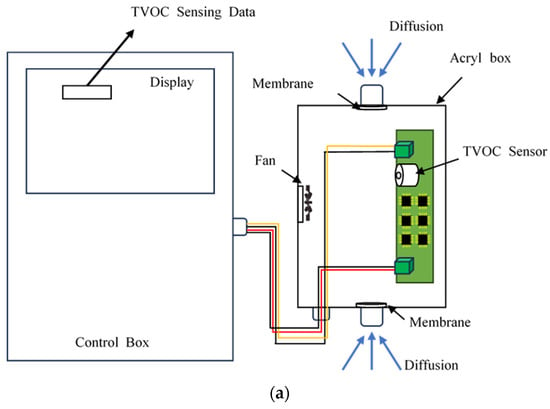
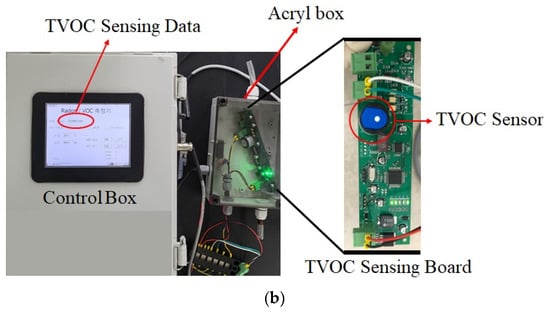
Figure 1.
(a) Schematics and (b) overall view of TVOC monitoring system.
To validate the TVOC monitoring system, Tedlar bags prepared at both lower concentrations (100, 200, 300, 400, and 500 ppbv) and higher concentrations (1000, 2000, 3000, 4000, and 5000 ppbv) were connected to the TD-GC to check the calibration curve. The identical Tedlar bag was subsequently employed for the validation of the TVOC monitoring system. The validation of the TVOC monitoring system involved two distinct methods: firstly, by opening the acryl box and facilitating the directed influx of a specific VOC flow into the TVOC sensor using a pump, and secondly, by introducing VOC into the acryl chamber to enable sensor measurement through diffusion. The TVOC measurements at both low and high concentrations for each method were validated using a calibration curve and comparison to those determined in the TD-GC system.
2.3. TD-GC System
TD (APK 2350, KNR Co., Seongnam, Gyeonggi-do, Republic of Korea) and GC/FID (Agilent 8890, Agilent Technologies, Santa Clara, CA, USA) were employed to analyze the BTEX separately (TD-GC system). Tenax TA, known for its excellent heat resistance (withstanding temperatures up to 350 °C) and its proficiency in adsorbing and desorbing VOCs [33,34], was loaded into the adsorption tube and installed within TD. The analysis conditions were as follows: The initial temperature of the valve in TD was 150 °C, with transfer line and adsorption temperatures at 180 °C and −20 °C, respectively. Adsorption lasted for a duration of 6.1 min, and desorption occurred with a flow rate of 50 mL/min at 320 °C. In GC, the inlet temperature was set at 250 °C, the detector was operated at 300 °C, and column was initially kept at 40 °C for 5 min. Subsequently, the temperature was ramped up to 100 °C at a rate of 10 °C/min and then further increased to 250 °C at 20 °C/min. The column flow was 1 mL/min, the split ratio was 15:1, and the split flow was 5 mL/min.
To establish the linear correlation between the adsorption quantity of BTEX and the peak area observed in GC analysis, the BTEX sampling conditions were systematically modified. This involved adjusting the adsorption time across different concentrations and flow rates. The BTEX adsorption quantity was determined on the basis of the GC data according to each concentration and flow condition. The assessment aimed to ascertain the reliability of BTEX analysis by utilizing the coefficient of determination (R2) derived from linear regression analysis applied to area data and BTEX adsorption amount. This was obtained through linear regression analysis of area data and BTEX adsorption. Accuracy and precision were calculated based on mean and standard deviation of seven consecutive data collections [35]. The experiments were conducted across three different flow conditions (50, 100, and 150 mL/min) and four distinct adsorption times (5, 10, 15, and 20 min).
2.4. Combination of TVOC Monitoring System and TD-GC System
The TVOC monitoring system and TD-GC system were connected sequentially, performing a simultaneous analysis of VOCs. A tedlar bag containing TVOC concentrations of 50, 500, and 5000 ppbv was linked to the inlet of the TVOC monitoring system through a tube for each respective concentration level. The outlet of the TVOC monitoring system was connected to TD-GC (Figure 2). The flow rate and adsorption time for TD-GC were selected by findings from the preceding validation test conducted for TD-GC. To assess the measurements of two systems within a consistent time frame, the TVOC monitoring system’s recorded values were averaged over the entire duration of sample adsorption in TD-GC system. The calibration curve for both TVOC monitoring system and TD-GC system was measured and utilized to compare the TVOC concentrations of two systems.
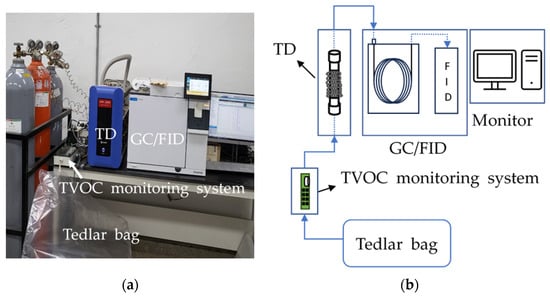
Figure 2.
(a) Experimental setup and (b) schematic view of TVOC monitoring system with TD-GC system.
2.5. Combination of TVOC Monitoring System and a Portable VOC Detector
TVOC monitoring system was compared to the commercially available portable VOC detector (RAE3000, Honeywell, Charlotte, NC, USA). A tedlar bag containing a BTEX standard gas sample at three different concentrations (50, 500, and 5000 ppbv) was affixed to the acrylic chamber (50 cm × 50 cm × 50 cm). The TVOC monitoring system was placed in the acrylic chamber, while the portable VOC detector was out of the chamber and connected to the chamber outlet out (Figure 3). The pump equipped with the portable VOC detector was utilized to facilitate the transfer of VOC gas from the tedlar bag to the chamber. The pump maintained a flow rate of 500 mL/min, enabling a gradual increase in VOC concentration in the chamber until it reached the VOC concentration initially prepared in the tedlar bag. Once the test setup was ready, the portable VOC detector was activated to pull the VOC gas into the chamber. The fan inside the chamber was also activated to equilibrize the VOC concentration in the chamber. The VOC concentration was monitored until it reached a stable equilibrium state.
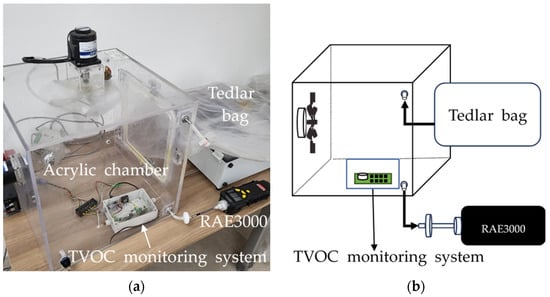
Figure 3.
(a) Experimental setup and (b) schematic view of TVOC monitoring system with a portable VOC detector.
2.6. VOC Transport in Soil Column
The combination of the TVOC monitoring system and TD-GC system (as noted in Section 2.3) was employed, incorporating a soil column between the TVOC monitoring system and the tedlar bag (Figure 4). A cylindrical acrylic column with a diameter of 50 mm and a height of 200 mm was used for the soil column experiment. A 1 mm-thick VOC permeable membrane was placed at the bottom of the column to fill the column with soil, allowing the passage of VOC gases through the column. For the type of soil used in the experiment, standard sand (Jumunjin sand, Gangneung, Republic of Korea) of 1.18~1.4 mm in size was used. Prior to the test, the sand was dried at 110 °C for 24 h in a drying oven. Following the complete filling of the soil column using dried sand, the inlet of the soil column was connected to a tedlar bag containing TVOC concentrations of 50, 500, or 5000 ppbv. Concurrently, the outlet of the soil column was connected to the input of the TVOC monitoring system. The condition for adsorption in the TD-GC was set at a flow rate of 150 mL/min with an adsorption duration of 20 min. Regarding the flow rate of the pump, the TD was maintained at a consistent flow rate of 150 mL/min during the soil column experiment, and the adsorption occurred every 43 min as scheduled in the TD-GC system.
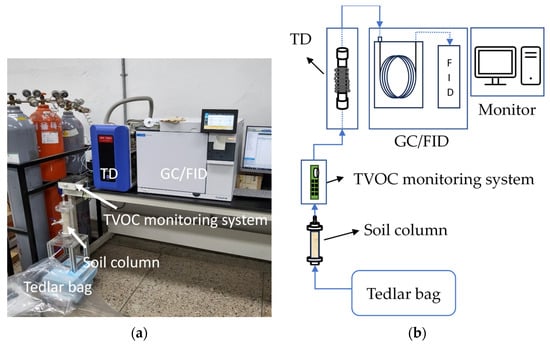
Figure 4.
(a) Experimental setup and (b) schematic view of VOC transport in soil.
3. Results and Discussion
3.1. Verification of TVOC Monitoring System
3.1.1. Precision and Accuracy
Based on the precision and accuracy of the TD-GC system across different flow rates (50, 100, and 150 mL/min) and adsorption durations (5, 10, 15, and 20 min), the optimum analytical condition was determined as a flow rate at 150 mL/min and an adsorption duration of 20 min (Tables S1–S6). As the molecular weight of VOC compound increased from benzene to toluene, ethylbenzene, and xylene, there was a marginal decrease in precision and accuracy, although primarily within an acceptable range.
When the VOC concentrations of low concentration range (100, 200, 300, 400, and 500 ppbv) and high concentration range (1000, 2000, 3000, 4000, and 5000 ppbv) were analyzed by both TD-GC and the TVOC monitoring system (with and without a pump), the R2 values obtained from the measurements conducted by the TD-GC and TVOC monitoring system demonstrated excellence performance, exceeding a value of 0.99 (Figure 5). A slightly decreased R2 was noted when the TVOC monitoring system was exposed to VOCs through diffusion without the use of a pump. This suggests that the TVOC monitoring system shows VOC measurement precision similar to that of TD-GC. It establishes that achieving highly accurate VOC measurements is feasible, even when employing diffusion-based measurement instead of the conventional approach of directing the flow to the sensor using a pump, as seen in typical portable VOC measuring devices.
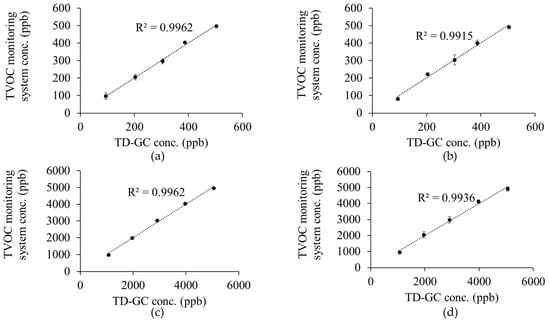
Figure 5.
VOC measurements by TD-GC and TVOC monitoring system at the following concentrations: (a) High concentration with pump; (b) High concentration without pump; (c) Low concentration with pump; (d) Low concentration without pump.
Subsequently, upon establishing a series connection between the TVOC monitoring system and TD-GC, as illustrated in Figure 2, the two systems concurrently analyzed VOC concentrations of 50, 500, and 5000 ppbv. Notably, the highest level of precision was noted in both TD-GC and the TVOC monitoring system at the highest concentration of 5000 ppbv, showing a decline in precision with decreased concentration. In terms of accuracy, the examined range of VOC concentrations revealed only a slight variance in accuracy. Nevertheless, a slight decline in the accuracy of the TVOC monitoring system was evident at the lowest concentration of 50 ppbv (Table 1). This demonstrated outstanding precision and accuracy in measuring VOC and highlighted a remarkably high correlation between TD-GC and the TVOC system.

Table 1.
Accuracy and precision of TVOC monitoring system and TD-GC according to VOC concentration (50, 500, 5000 ppbv).
3.1.2. Responsiveness
Further verification of the TVOC monitoring system was carried out with respect to its responsiveness to changes in concentration. When the VOC concentrations of 50, 500, and 5000 ppbv were simultaneously analyzed within a 50 cm × 50 cm × 50 cm acrylic chamber using both the TVOC monitoring system and a portable VOC detector, as shown in Figure 3, the TVOC monitoring system exhibited a comparatively slower convergence to the concentration levels. For example, the portable VOC detector achieved a concentration of 5000 ppbv within 40 min upon the injection of 5000 ppbv into the chamber, whereas the TVOC monitoring system required 50 min to reach the same level. The TVOC monitoring system experienced a comparable delay in arrival, irrespective of the concentration level of VOC within the tested range (Figure 6). The underlying reason for this phenomenon is postulated to stem from the variance in assessing VOC using sensor detection via diffusion versus advection. This was substantiated by noting that when directing the flow rate to the TVOC system sensor using a pump, its responsiveness closely matched that of the portable VOC detector.
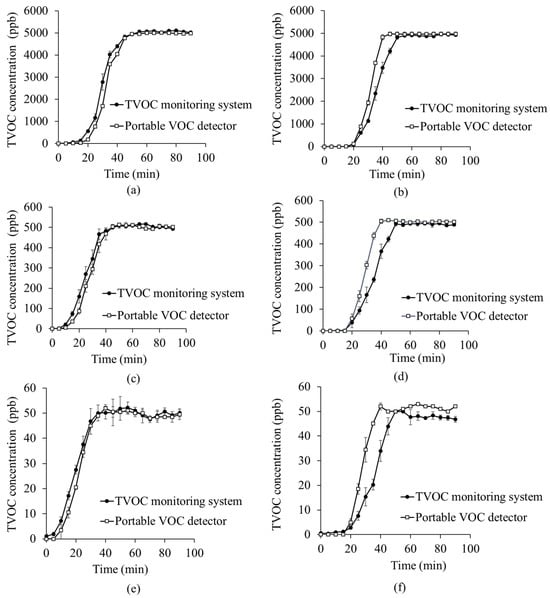
Figure 6.
Real-time VOC measurements of TVOC monitoring system and portable VOC detector when the surrounding VOC concentration was changed from 0 ppbv to the concentration of the following: (a) 5000 ppbv with pump; (b) 5000 ppbv without pump; (c) 500 ppbv with pump; (d) 500 ppbv without pump; (e) 50 ppbv with pump; (f) 50 ppbv without pump.
The time taken for the portable VOC detector and TVOC monitoring system to reach 10%, 20%, …, and 100% of the concentration of convergence is denoted as t10, t20, …, and t100, respectively (Table S7). The analysis compared the reaching times of the two devices, with and without the use of a pump in the TVOC monitoring system. In experiments conducted without a pump in the TVOC monitoring system, a maximum delay of up to 15 min was observed in the TVOC monitoring system compared to the portable VOC detector. As the designated VOC concentration decreased, the TVOC monitoring system’s reaching time extended, leading to a growing disparity between the two devices. In experiments conducted with a pump, the difference in reaching times between the two devices was less pronounced compared to experiments without a pump. In spite of the delayed responsiveness exhibited by the TVOC system, the system can be applicable where the change in VOC concentration takes place at a gradual pace, for instance, in subsurface areas.
3.2. Application to VOC Measurement through Soil Column
Since the TVOC monitoring system was designed to observe the VOC concentration in soil, the VOCs transported through the lab-scale sand pack column were examined by the TVOC monitoring system, connected in series with TD-GC, which served both as the driving force of VOC transport and for dual verification purposes. Throughout the experimental period, the VOCs were compelled to pass through the column by the pump equipped in the TD, maintaining a flow rate of 150 mL/min. When subjected to VOC concentrations of 50, 500, and 5000 ppbv, the level of responsiveness appears nearly identical to that of TD-GC due to the extension of the measurement interval, aligning with the 43-min analytical cycle of the GC (Figure S2). Within such a measurement interval and VOC concentration changes, the TVOC monitoring system demonstrated a commendable degree of precision and accuracy (Table 2). Given the relatively slow transport of VOCs within the soil layer through diffusion, it is anticipated that the TVOC monitoring system could function effectively as a continuous and real-time device for measuring VOCs within a concentration range from 50 ppbv to 5000 ppbv.

Table 2.
Accuracy and precision of TD-GC and TVOC monitoring system according to VOC concentrations (50, 500, and 5000 ppbv) through soil column.
Comparing the detection concentrations of BTEX gases over time during soil column penetration experiments using the TVOC monitoring system and TD-GC, it is observed that, at the initial detection data point of 23 min, the TVOC monitoring system exhibits higher BTEX gas detection concentrations compared to TD-GC (Figure 7). This is attributed to the experimental setup where TD-GC had a 20-min adsorption time when analyzing BTEX gases. The concentration of adsorbed BTEX on the adsorbent for the first 20 min represents the average concentration of BTEX gases penetrating the soil column. In other words, while the BTEX concentration at the column outlet was increased before reaching a steady state in the initial stages of the experiment, the 20-min average concentration was lower than the momentary concentration at 20 min. Consequently, the BTEX measurement values in the early stages of the experiment appear to be higher in the TVOC monitoring system compared to TD-GC, considering the short measurement intervals of the TVOC monitoring system in contrast to TD-GC. Analyzing the TD-GC data at 23 min reveals that benzene is detected in the highest quantity, followed by toluene, ethylbenzene, and xylene in sequence. This suggests that as BTEX gases permeate the soil-filled column, encountering interference from soil particles, they move along the interstitial pores, with the smallest molecular weight, benzene, being the first to penetrate the soil layer and be detected by TD-GC [36]. Toluene, being next in molecular weight and having a smaller molecular size than ethylbenzene, m,p-xylene, and o-xylene, was also detected earlier than the latter compounds.
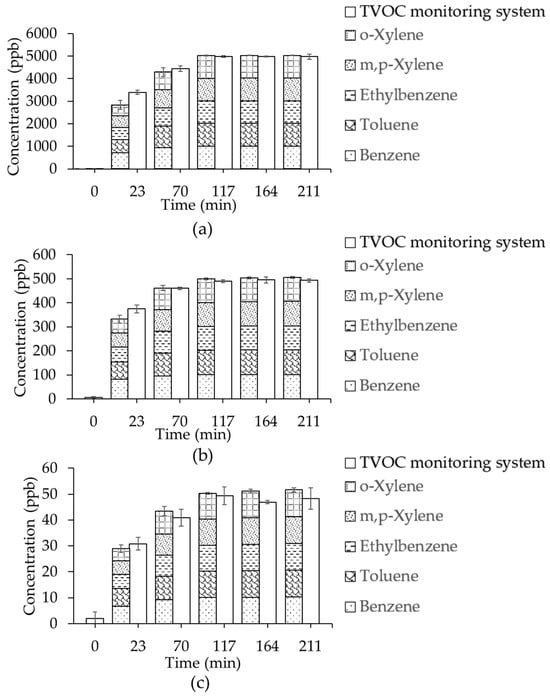
Figure 7.
VOC through soil measured by TD-GC and TVOC monitoring system according to concentration of the following: (a) 5000 ppbv; (b) 500 ppbv; (c) 50 ppbv.
The TVOC monitoring system has the advantage of measuring TVOC in real-time with short detection time intervals compared to TD-GC. This advantage allows for rapid measurement of TVOC in potentially contaminated sites, such as areas affected by petroleum pollution, without the need for suction flow. It enables long-term and stable continuous measurements. However, measurements at concentrations below 50 ppbv exhibit considerable variability, leading to some instability. Considering the site development where the previous land use is uncertain, the TVOC monitoring system demonstrates its value when applied to the soil layer. This is particularly advantageous in situations where a negative pressure can be built by implementing gas sampling of the portable VOC detector.
The performance of the TVOC monitoring system can be influenced by environmental factors such as temperature and humidity. While this study found insignificant measurement errors under the tested conditions, it is crucial to acknowledge that the field applications may present more intricate environmental conditions that might be difficult to implement in the laboratory. Considering the inherent impact of temperature and humidity on VOC monitoring sensors [37], finding effective operation and maintenance to alleviate these effects is crucial for accurate and reliable VOC monitoring. Therefore, regular calibrations under different environmental conditions are necessary to ensure the accuracy of measurements. Specifically, given the design of the sensor for waterproof operation, it is important to house the PID sensor in a waterproof container for optimal functionality. Also, for the potential use of the TVOC monitoring system as a portable detector, a reliable power supply is essential. Although the system tested in this study relied on batteries with regular replacement needs, integrating a self-sufficient power source, for example, a solar-based power supply, can ensure continuous and sustainable operation. Furthermore, real-time data acquisition would require users to analyze large datasets; therefore, incorporating an artificial intelligence-based data analysis for outlier detection and trend analysis would become imperative to handle the substantial volume of information. Above all, the continuous development of a PID sensor can enhance measurement sensitivity. To further enhance responsiveness and reliability, advancements in sensor design and functionality are required.
4. Conclusions
The TVOC monitoring system was developed by utilizing sample injection through diffusion, making it suitable for subsurface applications. The system aimed to incorporate the beneficial features of TD-GC and a portable VOC detector. The precision and accuracy of the TVOC monitoring system were in alignment with the TD-GC in established optimal experimental conditions. Even though the TVOC monitoring system exhibited a delayed response in comparison to the portable VOC detector, it demonstrated competitive responsiveness in cases characterized by a gradual and slow change in VOC concentration. Since the TVOC monitoring system is a diffusion-based gas monitoring system without altering the neighboring flows, it is another type of passive monitoring.
The TVOC monitoring system proposed in this study is expected to be a desirable device for monitoring VOC gas diffused from contaminated soil in the field. In particular, the TVOC monitoring system can find application in environmental and industrial policies aimed at regulating and controlling VOC emissions. Additionally, the data obtained by the TVOC monitoring system can support evidence-based decision-making in the development and implementation of policies related to VOC control and mitigation strategies. The sensor improvement needed to acquire high-precision measurement at a low concentration below 50 ppbv will allow further application of the TVOC monitoring system.
Supplementary Materials
The following supporting information can be downloaded at https://www.mdpi.com/article/10.3390/atmos15030245/s1, Table S1: Accuracy of TD-GC at 50 ppbv of TVOC under varying flowrate and adsorption time, Table S2: Precision of TD-GC at 50 ppbv of TVOC under varying flowrate and adsorption time, Table S3: Accuracy of TD-GC at 500 ppbv of TVOC under varying flowrate and adsorption time, Table S4: Precision of TD-GC at 500 ppbv of TVOC under varying flowrate and adsorption time, Table S5: Accuracy of TD-GC at 5000 ppbv of TVOC under varying flowrate and adsorption time, Table S6: Precision of TD-GC at 5000 ppbv of TVOC under varying flowrate and adsorption time, Table S7: Time to reach 10%, 20%, 30%, 40%, 50%, 60%, 70%, 80%, 90%, and 100% of the designated concentration of the portable VOC detector and TVOC monitoring system, Figure S1: Schematic view of gas sample preparation system, Figure S2: VOC through soil measured by TD-GC and TVOC monitoring system at TVOC concentration of (a) 5000 ppbv, (b) 500 ppbv, and (c) 50 ppbv.
Author Contributions
Writing—original draft preparation, formal analysis, investigation, J.H.; writing—review and editing, supervision, I.K. All authors have read and agreed to the published version of the manuscript.
Funding
This research was supported by Hongik University’s new faculty research support fund.
Institutional Review Board Statement
Not applicable.
Informed Consent Statement
Not applicable.
Data Availability Statement
The data presented in this study are available from the corresponding author on reasonable request. The data are not publicly available due to confidentiality of test data.
Conflicts of Interest
The authors declare no competing interests.
References
- Gakhar, T.; Basu, S.; Hazra, A. Carbon-Metal Oxide Nanocomposites for Selective Detection of Toxic and Hazardous Volatile Organic Compounds (VOC)—A Review. Green Anal. Chem. 2022, 1, 100005. [Google Scholar] [CrossRef]
- Guo, Y.; Wen, M.; Li, G.; An, T. Recent Advances in VOC Elimination by Catalytic Oxidation Technology onto Various Nanoparticles Catalysts: A Critical Review. Appl. Catal. B 2021, 281, 119447. [Google Scholar] [CrossRef]
- Feng, Y.; Xiao, A.; Jia, R.; Zhu, S.; Gao, S.; Li, B.; Shi, N.; Zou, B. Emission Characteristics and Associated Assessment of Volatile Organic Compounds from Process Units in a Refinery. Environ. Pollut. 2020, 265, 115026. [Google Scholar] [CrossRef] [PubMed]
- Qiu, W.; Li, S.; Liu, Y.; Lu, K. Petrochemical and Industrial Sources of Volatile Organic Compounds Analyzed via Regional Wind-Driven Network in Shanghai. Atmosphere 2019, 10, 760. [Google Scholar] [CrossRef]
- Unnithan, A.; Bekele, D.N.; Chadalavada, S.; Naidu, R. Insights into Vapour Intrusion Phenomena: Current Outlook and Preferential Pathway Scenario. Sci. Total Environ. 2021, 796, 148885. [Google Scholar] [CrossRef] [PubMed]
- Wang, L.; Lin, D.; Liu, R.; Li, J.; Xu, X. Emissions and Control Assessment of Volatile Organic Compounds from a Typical Chemical Enterprise. Atmosphere 2023, 14, 206. [Google Scholar] [CrossRef]
- Yao, D.; Li, C.; Niu, Q.; Gao, W.; Yu, H.; Yan, G.; Liu, J.; Cao, Z.; Wang, S.; Wang, Y. Characteristics of Volatile Organic Compounds and Their Contribution to Secondary Organic Aerosols during the High O3 Period in a Central Industry City in China. Atmosphere 2022, 13, 1625. [Google Scholar] [CrossRef]
- Liu, H.; Wang, N.; Chen, D.; Tan, Q.; Song, D.; Huang, F. How Photochemically Consumed Volatile Organic Compounds Affect Ozone Formation: A Case Study in Chengdu, China. Atmosphere 2022, 13, 1534. [Google Scholar] [CrossRef]
- Pankow, J.F.; Thomson, N.R.; Johnson, R.L.; Baehr, A.L.; Zogorski, J.S. The Urban Atmosphere as a Non-Point Source for the Transport of MTBE and Other Volatile Organic Compounds (VOCS) to Shallow Groundwater. Environ. Sci Technol 1997, 31, 2828. [Google Scholar] [CrossRef]
- You, K.; Zhan, H. Comparisons of Diffusive and Advective Fluxes of Gas Phase Volatile Organic Compounds (VOCs) in Unsaturated Zones under Natural Conditions. Adv. Water Resour. 2013, 52, 221–231. [Google Scholar] [CrossRef]
- Kwon, S.-M.; Choi, Y.-R.; Park, M.-K.; Lee, H.-J.; Kim, G.-R.; Yoo, S.-S.; Cho, S.-J.; Shin, J.-H.; Shin, Y.-S.; Lee, C. Health Risk Assessment with Source Apportionment of Ambient Volatile Organic Compounds in Seoul by Positive Matrix Factorization. J. Environ. Health Sci. 2021, 47, 384–397. [Google Scholar] [CrossRef]
- Sharma, N.; Agarwal, K.A.; Eastwood, P.; Gupta, T.; Singh Editors, A.P. Air Pollution and Control (Energy, Environment, and Sustainability); Springer: Singapore, 2018. [Google Scholar]
- Yousefian, F.; Hassanvand, M.S.; Nodehi, R.N.; Amini, H.; Rastkari, N.; Aghaei, M.; Yunesian, M.; Yaghmaeian, K. The Concentration of BTEX Compounds and Health Risk Assessment in Municipal Solid Waste Facilities and Urban Areas. Environ. Res. 2020, 191, 110068. [Google Scholar] [CrossRef] [PubMed]
- Rooseboom, M.; Kocabas, N.A.; North, C.; Radcliffe, R.J.; Segal, L. Recommendation for an Occupational Exposure Limit for Toluene. Regul. Toxicol. Pharmacol. 2023, 141, 105387. [Google Scholar] [CrossRef] [PubMed]
- Du, Q.; Chen, H.; Shi, Z.; Zhou, H. Case Report: Long Segmental Lesions of the Spinal Cord Caused by Exposure to Xylene. Front. Neurol. 2023, 14, 1121421. [Google Scholar] [CrossRef] [PubMed]
- Pang, X.; Lan, H.; Zhong, J.; Ye, D.; Shaw, M.D.; Lewis, A.C. Low-Cost Photoionization Sensors as Detectors in GC × GC Systems Designed for Ambient VOC Measurements. Sci. Total Environ. 2019, 664, 771–779. [Google Scholar] [CrossRef] [PubMed]
- Wei-Hao Li, M.; Ghosh, A.; Venkatasubramanian, A.; Sharma, R.; Huang, X.; Fan, X. High-Sensitivity Micro-Gas Chromatograph-Photoionization Detector for Trace Vapor Detection. ACS Sens. 2021, 6, 2348–2355. [Google Scholar] [CrossRef] [PubMed]
- Yaqub, G.; Hamid, A.; Khan, N.; Ishfaq, S.; Banzir, A.; Javed, T. Biomonitoring of Workers Exposed to Volatile Organic Compounds Associated with Different Occupations by Headspace GC-FID. J. Chem. 2020, 2020, 6956402. [Google Scholar] [CrossRef]
- Liaud, C.; Nguyen, N.T.; Nasreddine, R.; Le Calvé, S. Experimental Performances Study of a Transportable GC-PID and Two Thermo-Desorption Based Methods Coupled to FID and MS Detection to Assess BTEX Exposure at Sub-Ppb Level in Air. Talanta 2014, 127, 33–42. [Google Scholar] [CrossRef]
- Xiao, X.; Yan, B.; Fu, J.; Xiao, X. Absorption of Gaseous Toluene in Aqueous Solutions of Some Kinds of Fluorocarbon Surfactant. J. Air Waste Manag. Assoc. 2015, 65, 90–98. [Google Scholar] [CrossRef][Green Version]
- de Blas, M.; Gómez, M.C.; Navazo, M.; Alonso, L.; Durana, N.; Iza, J. Estimation of Unidentified Non-Methane Hydrocarbons in Urban Air Based on Highly Correlated Compound Pairs. Atmos. Environ. 2014, 98, 629–639. [Google Scholar] [CrossRef]
- Maceira, A.; Vallecillos, L.; Borrull, F.; Marcé, R.M. New Approach to Resolve the Humidity Problem in VOC Determination in Outdoor Air Samples Using Solid Adsorbent Tubes Followed by TD-GC–MS. Sci. Total Environ. 2017, 599–600, 1718–1727. [Google Scholar] [CrossRef] [PubMed]
- Hu, J.; Wu, J.; Yao, Q.; Wang, C.; Li, L.; Li, C. Research and Selection of Sorbents for Volatile Organic Compounds (VOC) Sampling Tubes. E3S Web. Conf. 2023, 441, 02008. [Google Scholar] [CrossRef]
- Marcillo, A.; Weiß, B.M.; Widdig, A.; Birkemeyer, C. Challenges of Fast Sampling of Volatiles for Thermal Desorption Gas Chromatography—Mass Spectrometry. J. Chromatogr. A 2020, 1617, 460822. [Google Scholar] [CrossRef] [PubMed]
- Duan, C.; Li, J.; Zhang, Y.; Ding, K.; Geng, X.; Guan, Y. Portable Instruments for On-Site Analysis of Environmental Samples. Trends Anal. Chem. 2022, 154, 116653. [Google Scholar] [CrossRef]
- Sekiguchi, H.; Matsushita, K.; Yamashiro, S.; Sano, Y.; Seto, Y.; Okuda, T.; Sato, A. On-Site Determination of Nerve and Mustard Gases Using a Field-Portable Gas Chromatograph-Mass Spectrometer. Forensic Toxicol. 2006, 24, 17–22. [Google Scholar] [CrossRef]
- Epping, R.; Koch, M. On-Site Detection of Volatile Organic Compounds (VOCs). Molecules 2023, 28, 1598. [Google Scholar] [CrossRef] [PubMed]
- Zhou, J.; Al Husseini, D.; Li, J.; Lin, Z.; Sukhishvili, S.; Coté, G.L.; Gutierrez-Osuna, R.; Lin, P.T. Detection of Volatile Organic Compounds Using Mid-Infrared Silicon Nitride Waveguide Sensors. Sci. Rep. 2022, 12, 5572. [Google Scholar] [CrossRef] [PubMed]
- Moura, P.C.; Vassilenko, V.; Ribeiro, P.A. Ion Mobility Spectrometry Towards Environmental Volatile Organic Compounds Identification and Quantification: A Comparative Overview over Infrared Spectroscopy. Emiss. Control Sci. Technol. 2023, 9, 25–46. [Google Scholar] [CrossRef]
- Bigazzi, A.Y.; Figliozzi, M.A. Roadway Determinants of Bicyclist Exposure to Volatile Organic Compounds and Carbon Monoxide. Transp. Res. Part D Transp. Environ. 2015, 41, 13–23. [Google Scholar] [CrossRef]
- Liang, Q.; Bao, X.; Sun, Q.; Zhang, Q.; Zou, X.; Huang, C.; Shen, C.; Chu, Y. Imaging VOC Distribution in Cities and Tracing VOC Emission Sources with a Novel Mobile Proton Transfer Reaction Mass Spectrometer. Environ. Pollut. 2020, 265, 114628. [Google Scholar] [CrossRef]
- Yue, R.; Chen, Z.; Liu, L.; Yin, L.; Qiu, Y.; Wang, X.; Wang, Z.; Mao, X. Combination of Steam-Enhanced Extraction and Electrical Resistance Heating for Efficient Remediation of Perchloroethylene-Contaminated Soil: Coupling Merits and Energy Consumption. Front. Environ. Sci. Eng. 2022, 16, 147. [Google Scholar] [CrossRef]
- Idris, S.A.; Robertson, C.; Morris, M.A.; Gibson, L.T. A Comparative Study of Selected Sorbents for Sampling of Aromatic VOCs from Indoor Air. Anal. Methods 2010, 2, 1803–1809. [Google Scholar] [CrossRef]
- Zhang, S.; Zhao, T.; Xu, X.; Wang, H.; Miao, C. Determination of BTEX Compounds in Solid-Liquid Mixing Paint Using the Combination of Solid Phase Extraction, Thermal Desorption and GC-FID. Chromatographia 2010, 71, 1131–1135. [Google Scholar] [CrossRef]
- Shin, M.C.; Jung, D.; Noh, H.; Yu, S.; Seo, Y.C.; Lee, B.M. Analysis of Volatile Organic Compounds in Sediments Using HS-GC/MS-Confirmation of Matrix Effects in External and Internal Standard Methods. J. Korean Soc. Water Environ. 2021, 21, 510–519. [Google Scholar] [CrossRef]
- Choudhary, V.R.; Nayak, V.S.; Choudhary, T. V Single-Component Sorption/Diffusion of Cyclic Compounds from Their Bulk Liquid Phase in H-ZSM-5 Zeolite. Ind. Eng. Chem. Res. 1997, 36, 1812–1818. [Google Scholar] [CrossRef]
- Soo, J.C.; Lee, E.G.; LeBouf, R.F.; Kashon, M.L.; Chisholm, W.; Harper, M. Evaluation of a Portable Gas Chromatograph with Photoionization Detector under Variations of VOC Concentration, Temperature, and Relative Humidity. J. Occup. Environ. Hyg. 2018, 15, 351–360. [Google Scholar] [CrossRef]
Disclaimer/Publisher’s Note: The statements, opinions and data contained in all publications are solely those of the individual author(s) and contributor(s) and not of MDPI and/or the editor(s). MDPI and/or the editor(s) disclaim responsibility for any injury to people or property resulting from any ideas, methods, instructions or products referred to in the content. |
© 2024 by the authors. Licensee MDPI, Basel, Switzerland. This article is an open access article distributed under the terms and conditions of the Creative Commons Attribution (CC BY) license (https://creativecommons.org/licenses/by/4.0/).